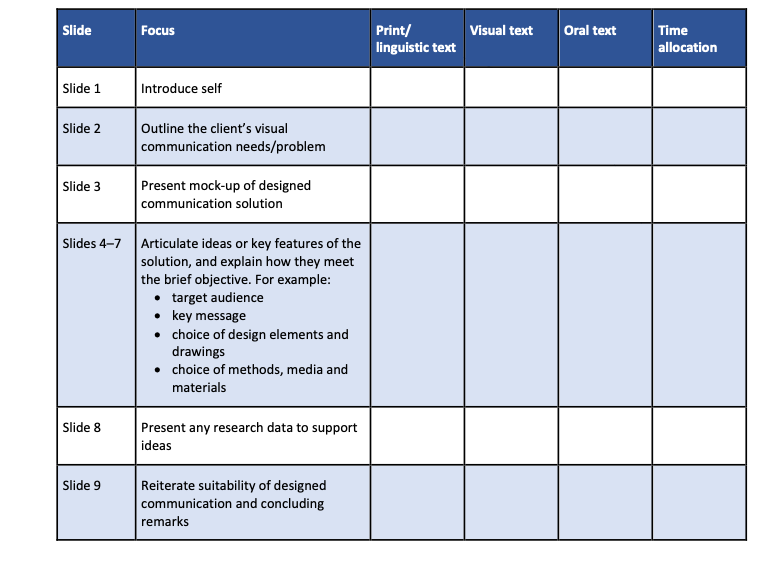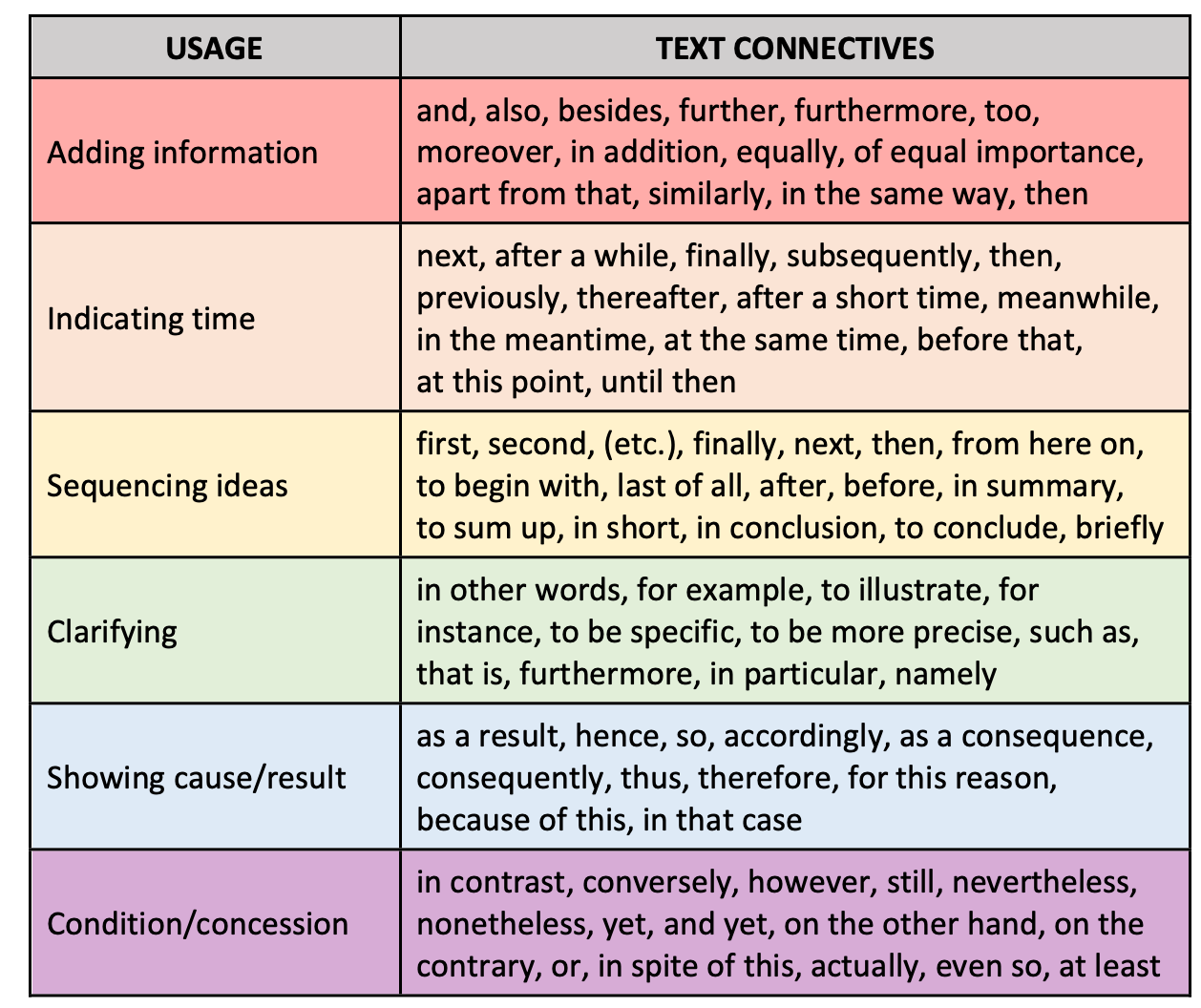The pitch – presenting visual communication concepts to an audience – is one of the extended texts that students must produce in Visual Communication Design (VCD).
The pitch is a multimodal presentation during which the designer speaks to design concepts they have developed in relation to the design brief for a specific 'client.'
For VCD students, the pitch is a simulation of a marketing strategy to discuss and justify the design solutions to promote them to the 'client.' In this context, the pitch may be presented to peers, teachers, or a broader audience to gain critique and constructive feedback during the design process. This feedback then informs the modifications to the design. Responding to this feedback is an essential part of the design process that students must undertake before reaching their final resolutions.
Preparing and presenting the pitch involves the following literacy demands:
- addressing each component of the design brief in a logical and cohesive structure
- describing, analysing, and evaluating visual communications
- designing a multimodal presentation in which modes of communication (for example, linguistic, visual, oral) complement one another
- applying and articulating design vocabulary associated with elements, principles, methods, media, and materials
- providing clear visual and written resources, including annotated designs
- delivering the presentation using appropriate oral language and non-verbal techniques
- using oral language strategies to inform, persuade and evaluate
- delivering a presentation for a specific audience and purpose.
While pitches can be delivered in a variety of creative ways, it is helpful to provide a structure to students that outlines the various elements that should be contained within a pitch.
The table below provides a structure for an oral pitch delivered with an accompanying PowerPoint presentation (or similar). The table supports students to plan a multimodal presentation in which oral, visual, and linguistic elements complement one another.
As students become more familiar with pitching ideas, they can also experiment with structure and sequencing to create more engaging pitches. Similarly, the sequence may also be modified according to the prior VCD experience and expertise of the students (for example, senior students may be required to deliver more than one 'Presentation' to the client).
In the table below:
- The print/linguistic text refers to the written language on the slide.
- Visual text refers to the images and diagrams on the slide.
- Oral text refers to the spoken language the students when the slide is showing.
- Time allocation is the amount of time the student will speak to each slide.

This strategy requires students to deconstruct and analyse student pitches as model texts. It is intended to support students' development and delivery of the 'pitch.' It assumes that students have already undertaken the design process, including research, generation of ideas and development of concepts (as per the figure below). Feedback from peers and teacher after the pitch enables student designers to refine and resolve their designs.
- Teacher initiates brainstorm:
- What is a pitch in VCD?
- Where else have you heard the word 'pitch'? (For example, in ball games, music, etc.).
- What is the purpose of the design pitch?
- To link designs to the client brief.
- To show the research and design process.
- To justify approaches, including the use of methods, media, materials, design elements and principles.
- Students view an example of VCD design pitch. Two example VCE student pitches include:
Before students view the example, the teacher poses
previewing prompts to guide students' engagement with and understanding of example:
- Identify the focus for each slide or stage of the presentation.
- Note how time is given to each stage.
- Observe how each stage/slide/idea connects to the next to create flow and cohesion.
- Teacher focuses on two or three slides/components from the model pitch. The teacher poses
during viewing questions about these slides, for example:
- What are the print texts, visual representations, and oral delivery components?
- How do they complement one another?
- How different components organised on the slide (For example, visualisation drawings, annotations, type, etc.)?
- What VCD-specific terminology/concepts are presented (for example, design elements and principles, methods, media, and materials)?
- What connective words are used to make links between components?
- When students have viewed the example, the teacher poses
after viewing questions such as:
- Is the presentation clearly structured? Is it cohesive?
- Is the presentation successful?
- Does the presentation meet the client's demands?
- Provide evidence for your responses to the above.
- Teacher and students synthesise responses.
- Teacher distributes proposed pitch structure (as above) and asks students to compare the template with the viewed presentation. The teacher may reshow the pitch to allow students to compare the structure and sequence of the example pitch.
- Students form small groups. The teacher asks students to discuss the following in their groups:
- Compare your observations of the example. Use your templates to assist your discussion.
- In your groups, decide on collective responses to the following questions:
- What were the most successful elements of the presentation? Why?
- What could have been modified or improved? Why?
- Students report back to the whole class.
The teacher may repeat the above with additional example pitches.
- Students plan their pitches using the pitch structure or another organiser.
- When finalising presentations, the teacher distributes a list of connective words. The teacher asks the students to identify any of the connectives that will be useful to create cohesion at different stages in their presentations.

(adapted from Derewianka, 2011, pp. 153-4)
Prepositions, prepositional phrases, and adverbs will also be used to indicate location:
above, behind, below, beyond, here, there, to the right (left), nearby, opposite, on the other side, in the background, along the wall, at the top, across, adjacent to
Curriculum links for the above example:
VCAVCDE001,
VCAVCDP003,
VCAVCDE006,
VCAVCDE007.
Learning sequence
The learning sequence for Levels 9 and 10 in Visual Communication Design, demonstrates how literacy teaching strategies can be used in a sequence.
A learning sequence tool is also available to assist in the planning of Visual Communication Design and Literacy across a series of lessons.
Derewianka, B. (2011).
A new grammar companion for teachers. Newtown: PETAA.
Victorian Curriculum and Assessment Authority (2016).
Victorian Certificate of Education Visual Communication Design Study Design, 2018 – 2022. Retrieved at:
https://www.vcaa.vic.edu.au/Documents/vce/visualcomm/VisualCommunicationDesignSD_2018.pdf